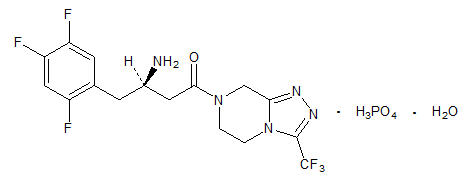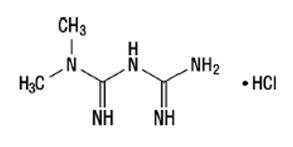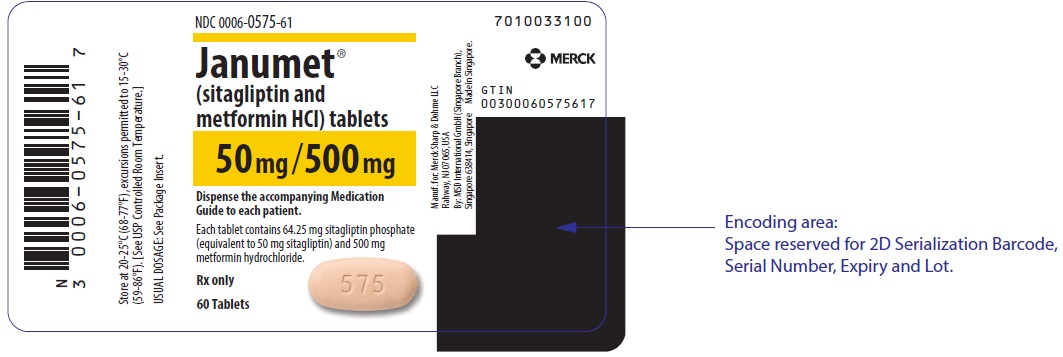Sitagliptin
Generic name: sitagliptin
Brand name: Januvia
Dosage form: oral tablet (100 mg; 25 mg; 50 mg)
Drug class: Dipeptidyl peptidase 4 inhibitors
Medically reviewed by A Ras MD.
What is sitagliptin used for?
Sitagliptin is a prescription medicine that is used to lower blood sugar in patients with high blood sugar (diabetes).
Description
JANUMET (sitagliptin and metformin HCl) tablets for oral use contain two antihyperglycemic drugs: sitagliptin and metformin HCl.
Sitagliptin
Sitagliptin is an orally-active inhibitor of the dipeptidyl peptidase-4 (DPP-4) enzyme. Sitagliptin is present in JANUMET tablets in the form of sitagliptin phosphate monohydrate. Sitagliptin phosphate monohydrate is described chemically as 7-[(3R)-3-amino-1-oxo-4-(2,4,5-trifluorophenyl)butyl]-5,6,7,8-tetrahydro-3-(trifluoromethyl)-1,2,4-triazolo[4,3-a]pyrazine phosphate (1:1) monohydrate with an empirical formula of C16H15F6N5O∙H3PO4∙H2O and a molecular weight of 523.32. The structural formula is:

Sitagliptin phosphate monohydrate is a white to off-white, crystalline, non-hygroscopic powder. It is soluble in water and N,N-dimethyl formamide; slightly soluble in methanol; very slightly soluble in ethanol, acetone, and acetonitrile; and insoluble in isopropanol and isopropyl acetate.
Metformin HCl
Metformin HCl (N,N-dimethylimidodicarbonimidic diamide hydrochloride) is not chemically or pharmacologically related to any other classes of oral antihyperglycemic agents. Metformin HCl is a white to off-white crystalline compound with a molecular formula of C4H11N5∙HCl and a molecular weight of 165.63. Metformin HCl is freely soluble in water and is practically insoluble in acetone, ether, and chloroform. The pKa of metformin HCl is 12.4. The pH of a 1% aqueous solution of metformin HCl is 6.68. The structural formula is as shown:

JANUMET
JANUMET is available as film-coated tablets containing:
- 64.25 mg sitagliptin monohydrate equivalent to 50 mg of sitagliptin and 389.93 mg of metformin equivalent to 500 mg metformin HCl (JANUMET 50/500).
- 64.25 mg sitagliptin monohydrate equivalent to 50 mg of sitagliptin and 779.86 mg of metformin equivalent to 1000 mg metformin HCl (JANUMET 50/1000).
Each film-coated tablet of JANUMET contains the following inactive ingredients: microcrystalline cellulose, polyvinylpyrrolidone, sodium lauryl sulfate, and sodium stearyl fumarate. In addition, the film coating contains the following inactive ingredients: polyvinyl alcohol, polyethylene glycol, talc, titanium dioxide, red iron oxide, and black iron oxide.
Mechanism of Action
JANUMET
JANUMET combines two antihyperglycemic agents with complementary mechanisms of action to improve glycemic control in patients with type 2 diabetes mellitus: sitagliptin, a dipeptidyl peptidase-4 (DPP-4) inhibitor, and metformin HCl, a member of the biguanide class.
Sitagliptin
Sitagliptin is a DPP-4 inhibitor, which is believed to exert its actions in patients with type 2 diabetes by slowing the inactivation of incretin hormones. Concentrations of the active intact hormones are increased by sitagliptin, thereby increasing and prolonging the action of these hormones. Incretin hormones, including glucagon-like peptide-1 (GLP-1) and glucose-dependent insulinotropic polypeptide (GIP), are released by the intestine throughout the day, and levels are increased in response to a meal. These hormones are rapidly inactivated by the enzyme DPP-4. The incretins are part of an endogenous system involved in the physiologic regulation of glucose homeostasis. When blood glucose concentrations are normal or elevated, GLP-1 and GIP increase insulin synthesis and release from pancreatic beta cells by intracellular signaling pathways involving cyclic AMP. GLP-1 also lowers glucagon secretion from pancreatic alpha cells, leading to reduced hepatic glucose production. By increasing and prolonging active incretin levels, sitagliptin increases insulin release and decreases glucagon levels in the circulation in a glucose-dependent manner. Sitagliptin demonstrates selectivity for DPP-4 and does not inhibit DPP-8 or DPP-9 activity in vitro at concentrations approximating those from therapeutic doses.
Metformin
Metformin is an antihyperglycemic agent which improves glucose tolerance in patients with type 2 diabetes mellitus, lowering both basal and postprandial plasma glucose. Metformin decreases hepatic glucose production, decreases intestinal absorption of glucose, and improves insulin sensitivity by increasing peripheral glucose uptake and utilization. With metformin therapy, insulin secretion remains unchanged while fasting insulin levels and day-long plasma insulin response may decrease.
Before taking sitagliptin, tell your doctor:
- If you are allergic to sitagliptin; any part of this medicine; or any other drugs, foods, or substances. Tell your doctor about the allergy and what signs you had.
- If you have any of these health problems: Acidic blood problem or type 1 diabetes.
This is not a list of all drugs or health problems that interact with sitagliptin.
Tell your doctor and pharmacist about all of your drugs (prescription or OTC, natural products, vitamins) and health problems. You must check to make sure that it is safe for you to take sitagliptin with all of your drugs and health problems. Do not start, stop, or change the dose of any drug without checking with your doctor.
What are some things I need to know or do while I take sitagliptin?
- Tell all of your health care providers that you take sitagliptin. This includes your doctors, nurses, pharmacists, and dentists.
- Do not drive if your blood sugar has been low. There is a greater chance of you having a crash.
- Check your blood sugar as you have been told by your doctor.
- Have blood work checked as you have been told by the doctor. Talk with the doctor.
- Talk with your doctor before you drink alcohol.
- Follow the diet and workout plan that your doctor told you about.
- It may be harder to control blood sugar during times of stress such as fever, infection, injury, or surgery. A change in physical activity, exercise, or diet may also affect blood sugar.
- A skin reaction called bullous pemphigoid has happened with drugs like this one. Sometimes, people have had to go to the hospital. Call your doctor right away if you have blisters or if your skin starts to break down.
- Heart failure has happened in people taking drugs like this one. Tell your doctor if you have ever had heart failure or kidney problems. Call your doctor right away if you feel very tired or you have shortness of breath, a big weight gain, or swelling in the arms or legs.
- Kidney problems have happened. Sometimes, these may need to be treated in the hospital or with dialysis.
- If you are 65 or older, use sitagliptin with care. You could have more side effects.
- Tell your doctor if you are pregnant, plan on getting pregnant, or are breast-feeding. You will need to talk about the benefits and risks to you and the baby.
How is sitagliptin best taken?
Use sitagliptin as ordered by your doctor. Read all information given to you. Follow all instructions closely.
- Take with or without food.
- Keep taking sitagliptin as you have been told by your doctor or other health care provider, even if you feel well.
What do I do if I miss a dose?
- Take a missed dose as soon as you think about it.
- If it is close to the time for your next dose, skip the missed dose and go back to your normal time.
- Do not take 2 doses at the same time or extra doses.
What are the side effects of sitagliptin that I need to call my doctor about immediately?
WARNING/CAUTION: Even though it may be rare, some people may have very bad and sometimes deadly side effects when taking a drug. Tell your doctor or get medical help right away if you have any of the following signs or symptoms that may be related to a very bad side effect:
- Signs of an allergic reaction, like rash; hives; itching; red, swollen, blistered, or peeling skin with or without fever; wheezing; tightness in the chest or throat; trouble breathing, swallowing, or talking; unusual hoarseness; or swelling of the mouth, face, lips, tongue, or throat.
- Signs of kidney problems like unable to pass urine, change in how much urine is passed, blood in the urine, or a big weight gain.
- Low blood sugar can happen. The chance may be raised when sitagliptin is used with other drugs for diabetes. Signs may be dizziness, headache, feeling sleepy or weak, shaking, fast heartbeat, confusion, hunger, or sweating. Call your doctor right away if you have any of these signs. Follow what you have been told to do for low blood sugar. This may include taking glucose tablets, liquid glucose, or some fruit juices.
- Severe and sometimes deadly pancreas problems (pancreatitis) have happened with sitagliptin. This could happen at any time during treatment. Signs of pancreatitis include very bad stomach pain, very bad back pain, or very upset stomach or throwing up. Call your doctor right away if you have any of these signs.
- A very bad skin reaction (Stevens-Johnson syndrome/toxic epidermal necrolysis) may happen. It can cause very bad health problems that may not go away, and sometimes death. Get medical help right away if you have signs like red, swollen, blistered, or peeling skin (with or without fever); red or irritated eyes; or sores in your mouth, throat, nose, or eyes.
- Drugs like this one may cause joint pain that can be very bad and disabling. Call your doctor right away if you have very bad joint pain or any joint pain that does not go away.
What are some other side effects of sitagliptin?
All drugs may cause side effects. However, many people have no side effects or only have minor side effects. Call your doctor or get medical help if any of these side effects or any other side effects bother you or do not go away:
- Headache.
- Signs of a common cold.
- Nose or throat irritation.
These are not all of the side effects that may occur. If you have questions about side effects, call your doctor. Call your doctor for medical advice about side effects.
You may report side effects to the FDA at 1-800-332-1088. You may also report side effects at https://www.fda.gov/medwatch.
If overdose is suspected:
If you think there has been an overdose, call your poison control center or get medical care right away. Be ready to tell or show what was taken, how much, and when it happened.
How do I store and/or throw out sitagliptin?
- Store at room temperature.
- Store in a dry place. Do not store in a bathroom.
- Keep all drugs in a safe place. Keep all drugs out of the reach of children and pets.
- Throw away unused or expired drugs. Do not flush down a toilet or pour down a drain unless you are told to do so. Check with your pharmacist if you have questions about the best way to throw out drugs. There may be drug take-back programs in your area.
Label
PRINCIPAL DISPLAY PANEL – 50 MG/500 MG TABLET BOTTLE LABEL
- NDC 0006-0575-61
- Janumet®
(sitagliptin and
metformin HCl) tablets - 50 mg/500 mg
- Dispense the accompanying Medication
Guide to each patient. - Each tablet contains 64.25 mg sitagliptin phosphate
(equivalent to 50 mg sitagliptin) and 500 mg
metformin hydrochloride. - Rx only
- 60 Tablets

PRINCIPAL DISPLAY PANEL – 50 MG/1,000 MG TABLET BOTTLE LABEL
- NDC 0006-0577-61
- Janumet®
(sitagliptin and
metformin HCl) tablets - 50 mg/1,000 mg
- Dispense the accompanying Medication Guide
to each patient. - Each tablet contains 64.25 mg sitagliptin phosphate
(equivalent to 50 mg sitagliptin) and 1,000 mg
metformin hydrochloride. - Rx only
- 60 Tablets

SRC: NLM .
